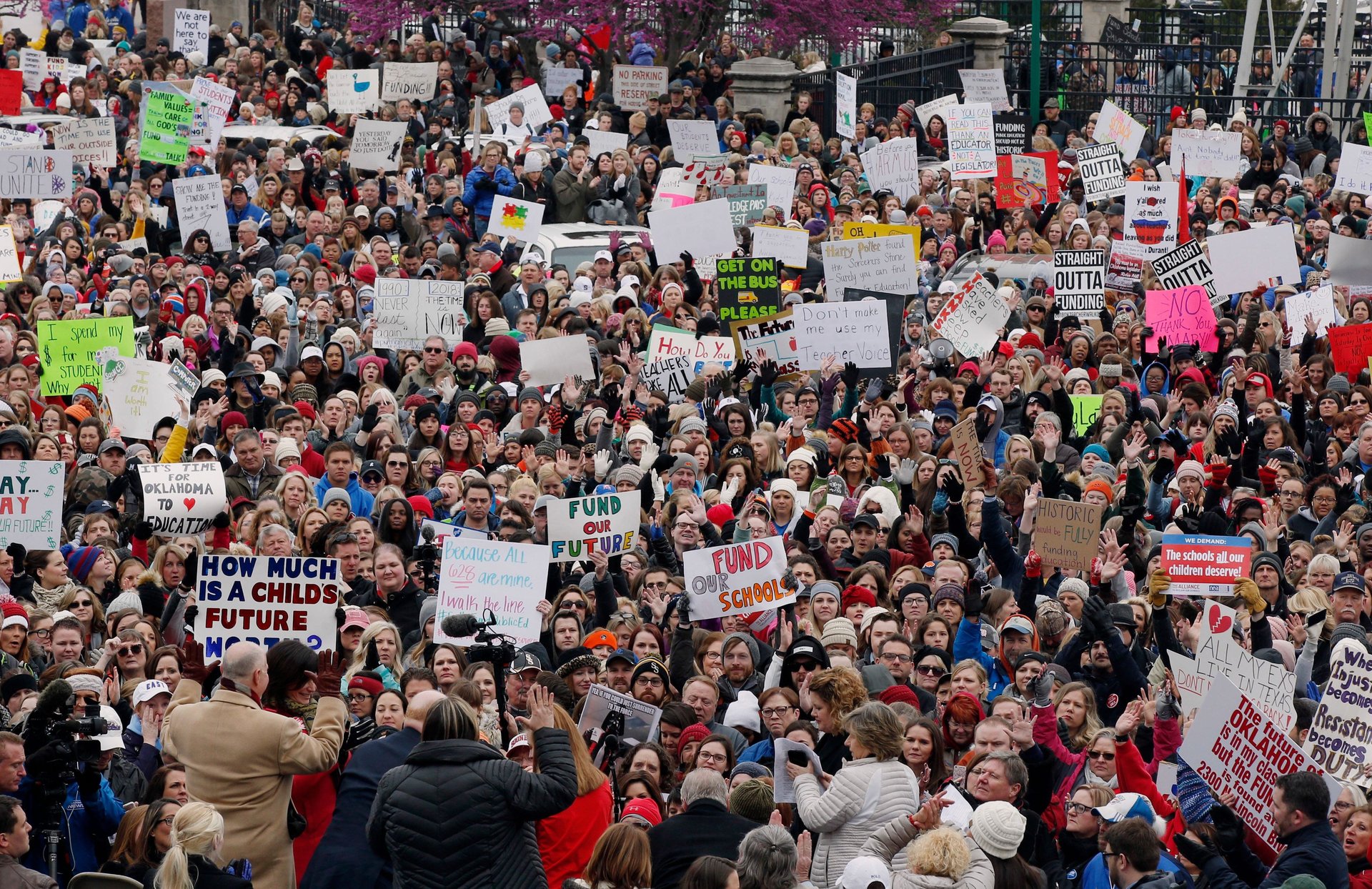Charted: The disastrous economic decisions behind Oklahoma’s teachers strike
Thousands of US public school teachers from Oklahoma walked out of classrooms yesterday to protest huge cuts to state education funding. They’re protesting what some call a “crisis” in the Oklahoma economy and political system, which stripped funding from school supplies and salaries while giving huge tax cuts to corporations.


Thousands of US public school teachers from Oklahoma walked out of classrooms yesterday to protest huge cuts to state education funding. They’re protesting what some call a “crisis” in the Oklahoma economy and political system, which stripped funding from school supplies and salaries while giving huge tax cuts to corporations.
Oklahoma teachers say they have been forced to work second jobs to pay their bills, and school districts have cut classes to four days a week to save money. “I feel like they’re choosing oil and gas over education,” one public school teacher told Tulsa World. “I work additional jobs because my teaching salary isn’t enough to provide for my family,” another striking Oklahoma veteran teacher explained. It’s not just salaries—”I have just 29 textbooks for 87 pupils,” another teacher told the BBC.
The Oklahoma teachers are expected to continue their strike today.
More than 90% of US families rely on the country’s public schools, but state funding for those schools fell dramatically after the 2008 recession, when property taxes plummeted with real estate values. Overall, funding for public education has started to rebound in recent years, as real estate prices went back up.
Some states, though, have exacerbated the recession’s problems with deep cuts to corporate and personal income taxes, says the Center on Budget and Policy Priorities (CBPP), a non-partisan non-profit that pushes for state fiscal responsibility. And Oklahoma happens to lead the country in cutting funding per student for education, over the past decade.
The state adopted tax-slashing policies under Democratic governor Brad Henry and continued under the current Republican governor Mary Fallin, who was elected in 2010 with Tea Party support, on a platform of criticizing Obamacare and federal taxes.
The state’s overall budget was slashed by 15.6% from fiscal year 2009 to 2018, when adjusted for inflation, according to the Oklahoma Policy Institute, a non-partisan research agency on state policies.
Here’s how Oklahoma’s money disappeared:
Oklahoma’s income tax cuts
First, Oklahoma politicians slashed the income tax rate, predicting that the cuts would increase overall consumer spending and attract more businesses to the state, much like the justification for the Trump administration-backed federal tax cuts passed this year. (Unlike the federal government, states are not allowed to carry a budget deficit from year to year, meaning that any cuts in income need to be offset immediately but cuts in spending.)
These cuts went overwhelmingly to the state’s richest, with the top 20% of the state’s households getting 72% of the benefit on a overall dollar value, the Oklahoma Policy Institute found. The state’s richest also pay less as a percentage of income, with the top 1% paying just 4.3% in income tax in 2015, versus 10.5% for the poorest 20% of taxpayers.
Oklahoma’s tax breaks for oil and gas
Overall corporate taxes in Oklahoma have held steady at 6%, and make up just a fraction of overall state revenue. But Oklahoma also passed drastic tax breaks for oil and gas companies, despite the fact that Oklahoma City had already attracted plenty of corporate investment to become a fracking boomtown in the early 2000s.
In 2014, as petroleum prices were plummeting, Oklahoma passed a law that lowered “gross production tax” for oil and gas from 7% to 2% for new oil wells for 36 months. That made Oklahoma’s taxes on the industry the lowest of any oil-producing state. Revenue collected by the state plummeted.
The tax break cost Oklahoma’s state budget as much as $470 million in fiscal year 2015 alone. It has cost hundreds of millions of dollars every year since, Oklahoma Policy institute estimates.
Oklahoma teachers are among America’s worst-paid
Overall, tax cuts like these inevitably affect education budgets; state governments fund about half of the cost of public schools, with local taxes and federal programs kicking in the rest. A huge chunk of education spending is teacher salaries. Today, Oklahoma teachers are among the worst-paid in the nation, just after Mississippi and South Dakota.
Overall, the US pays its public high school teachers less than any other developed nation besides the Czech Republic.
“It’s hard to imagine a state doing year-after-year tax cuts without ultimately sacrificing teacher pay,” said Nick Johnson, the senior vice president for state fiscal policy at CBPP. “There is no way you can have competitive teacher salaries or get the best workforce possible without an adequate revenue stream,” he said.